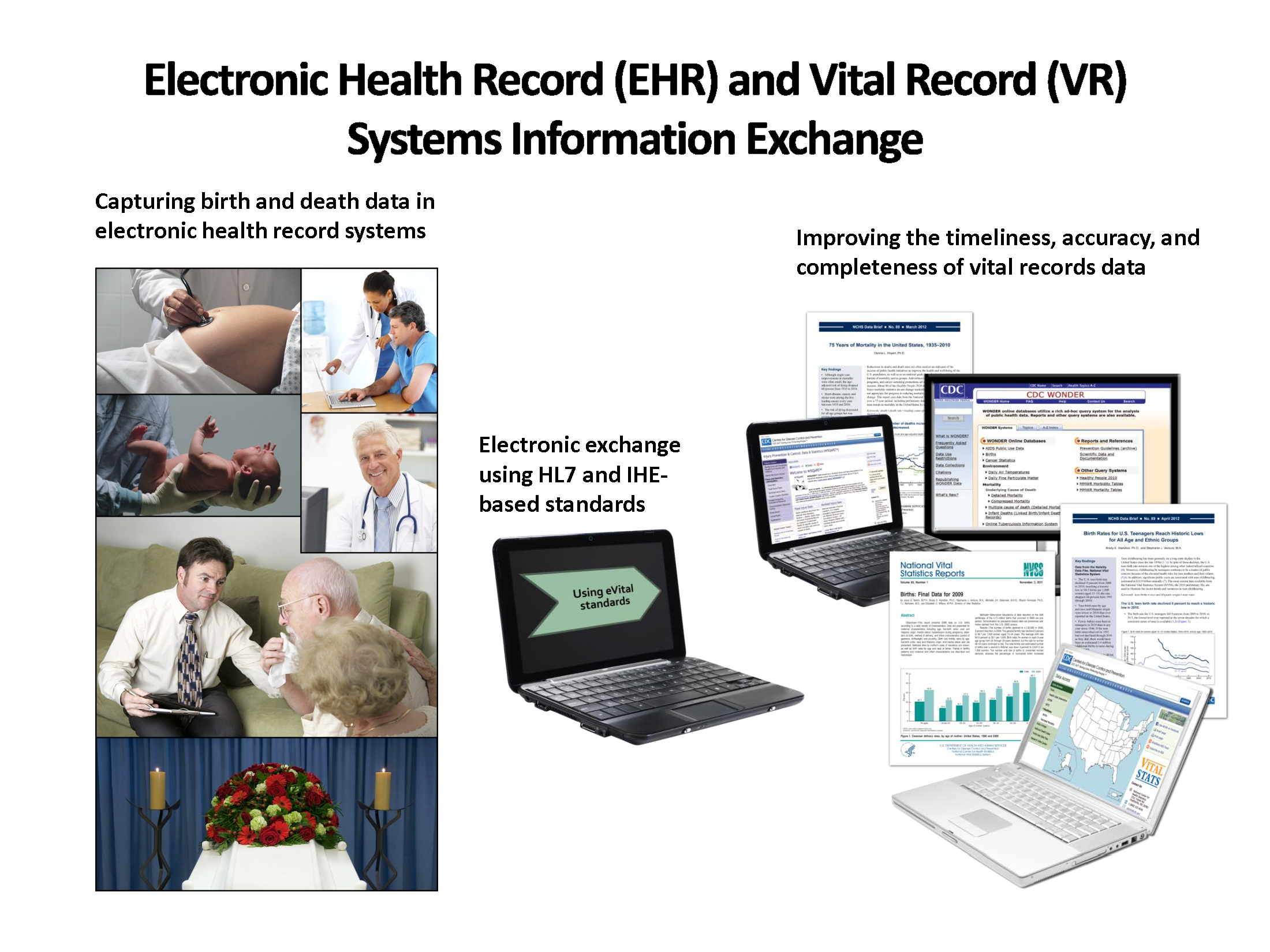Difference between revisions of "Vital Records Death Reporting"
Mwilliamson (talk | contribs) |
JohnMoehrke (talk | contribs) |
||
| (15 intermediate revisions by 5 users not shown) | |||
| Line 1: | Line 1: | ||
Vital Records Death Reporting defines a Retrieve Form for Data Capture (RFD) content profile that will specify derivation of source content from a medical summary document. by defining requirements for form filler content and form manager handling of the content.: | Vital Records Death Reporting defines a Retrieve Form for Data Capture (RFD) content profile that will specify derivation of source content from a medical summary document. by defining requirements for form filler content and form manager handling of the content.: | ||
| + | |||
| + | '''[https://ihe.webex.com/ihe/lsr.php?RCID=a8385437eab541ad6ba5fe5304d5069a Birth and Fetal Death Reporting Enhanced Profile and Vital Records Death Reporting Recording]''' | ||
__TOC__ | __TOC__ | ||
==Summary== | ==Summary== | ||
| − | + | The Vital Records Death Reporting Content Profile supports pre-population of data from electronic health record systems to electronic vital records systems for death reporting to meet Federal, state and local reporting requirements. | |
==Benefits== | ==Benefits== | ||
| Line 17: | Line 19: | ||
==Details== | ==Details== | ||
| − | + | Vital statistics data are the basis for national and state information relevant for promoting public health and for aiding decision makers in setting policies, directing resources, managing problems, and identifying emerging health trends. Vital Records Death Reporting is part of the process of creating the legal record of a person’s death. The provider caring for the patient at the time of death is responsible for reporting medical details on death. Some of the information that is to be reported in the death record exists within the EHR. This profile will define an RFD-based content profile that will specify derivation of source content from a medical summary document. The profile will define requirements for form filler content and form manager handling of content. This profile defines messaging from the provider to the jurisdiction. This profile will define messaging from the jurisdiction, round-trip to the national re-population using FHIR. | |
| + | |||
| + | [[File:BFDR and VRDR Graphic.png |500x400px]] | ||
| + | |||
| + | '' | ||
==Systems Affected== | ==Systems Affected== | ||
| Line 24: | Line 30: | ||
:* Electronic Death Registration Systems (EDRS) | :* Electronic Death Registration Systems (EDRS) | ||
:* Infrastructure (Forms Manager) | :* Infrastructure (Forms Manager) | ||
| + | :* National Vital Records Statistics Systems | ||
'' | '' | ||
| + | [[Image:VRDR Actor Diagram 2014Dec.png|1000x900px]] | ||
| + | |||
| + | [[Image:VRDR actors and transactions table.png|600x500px]] | ||
==Specification== | ==Specification== | ||
| Line 38: | Line 48: | ||
•HL7 Version 3 CDA R2 Implementation Guide: Reporting Death Information from the EHR to Vital Records Release 1 US Realm - Draft Standard for Trial Use) | •HL7 Version 3 CDA R2 Implementation Guide: Reporting Death Information from the EHR to Vital Records Release 1 US Realm - Draft Standard for Trial Use) | ||
| + | |||
| + | ==FHIR Implementation Guide== | ||
==See Also== | ==See Also== | ||
| − | + | 1. HL7 and other standards documents referenced in Volume 1 and Volume 2 | |
| − | |||
| − | |||
| − | |||
| − | |||
| − | |||
| − | |||
| − | |||
| − | |||
| − | |||
| − | |||
| − | |||
| − | |||
| − | |||
| − | |||
| − | |||
| − | |||
| − | |||
| − | |||
| − | |||
| − | |||
| − | |||
| − | |||
| − | |||
| − | |||
| − | |||
| − | |||
| − | |||
| + | 2. Death Edit Specifications for the 2003 Revision of the U.S. Standard Certificate of Death | ||
| − | + | [[Category:Profiles]] | |
| + | [[Category:QRPH Profile]] | ||
| + | [[Category:CDA]] | ||
| + | [[Category:HL7v2]] | ||
| + | [[Category:FHIR]] | ||
Latest revision as of 10:55, 6 November 2019
Vital Records Death Reporting defines a Retrieve Form for Data Capture (RFD) content profile that will specify derivation of source content from a medical summary document. by defining requirements for form filler content and form manager handling of the content.:
Birth and Fetal Death Reporting Enhanced Profile and Vital Records Death Reporting Recording
Summary
The Vital Records Death Reporting Content Profile supports pre-population of data from electronic health record systems to electronic vital records systems for death reporting to meet Federal, state and local reporting requirements.
Benefits
- Establishes interoperable electronic exchange of VR data between EHR and VR Systems
- More timely data release
- Higher quality data for demographic and epidemiologic surveillance and research
- Less costly electronic vital registration systems
- Greater integration with other stakeholder electronic systems
- Greater standardization of electronic Vital Records data collection and exchange
Details
Vital statistics data are the basis for national and state information relevant for promoting public health and for aiding decision makers in setting policies, directing resources, managing problems, and identifying emerging health trends. Vital Records Death Reporting is part of the process of creating the legal record of a person’s death. The provider caring for the patient at the time of death is responsible for reporting medical details on death. Some of the information that is to be reported in the death record exists within the EHR. This profile will define an RFD-based content profile that will specify derivation of source content from a medical summary document. The profile will define requirements for form filler content and form manager handling of content. This profile defines messaging from the provider to the jurisdiction. This profile will define messaging from the jurisdiction, round-trip to the national re-population using FHIR.
Systems Affected
==Systems Affected==
- EHR Systems
- Electronic Death Registration Systems (EDRS)
- Infrastructure (Forms Manager)
- National Vital Records Statistics Systems
Specification
Trial Implementation
Documents: http://www.ihe.net/uploadedFiles/Documents/QRPH/IHE_QRPH_Suppl_VRDR.pdf
Underlying Standards:
•HL7 Version 2.5.1 Implementation Guide: Reporting Death Information from the EHR to Vital Records, R1 US Realm (Draft Standard for Trial Use)
•HL7 Version 3 CDA R2 Implementation Guide: Reporting Death Information from the EHR to Vital Records Release 1 US Realm - Draft Standard for Trial Use)
FHIR Implementation Guide
See Also
1. HL7 and other standards documents referenced in Volume 1 and Volume 2
2. Death Edit Specifications for the 2003 Revision of the U.S. Standard Certificate of Death


